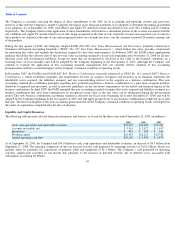Apple 2009 Annual Report Download - page 42
Download and view the complete annual report
Please find page 42 of the 2009 Apple annual report below. You can navigate through the pages in the report by either clicking on the pages listed below, or by using the keyword search tool below to find specific information within the annual report.
Table of Contents
The allowance for doubtful accounts is based on management’
s assessment of the ability to collect specific customer accounts and includes
consideration of the credit-
worthiness and financial condition of those specific customers. The Company records an allowance to reduce the
specific receivables to the amount that it reasonably believes to be collectible. The Company also records an allowance for all other trade
receivables based on multiple factors, including historical experience with bad debts, the general economic environment, the financial condition
of the Company’s distribution channels, and the aging of such receivables. If there is a deterioration of a major customer’
s financial condition, if
the Company becomes aware of additional information related to the credit-
worthiness of a major customer, or if future actual default rates on
trade receivables in general differ from those currently anticipated, the Company may have to adjust its allowance for doubtful accounts, which
would affect its results of operations in the period the adjustments are made.
Inventory Valuation and Inventory Purchase Commitments
The Company must order components for its products and build inventory in advance of product shipments. The Company records a write-
down
for inventories of components and products, including third-
party products held for resale, which have become obsolete or are in excess of
anticipated demand or net realizable value. The Company performs a detailed review of inventory each fiscal quarter that considers multiple
factors including demand forecasts, product life cycle status, product development plans, current sales levels, and component cost trends. The
personal computer, mobile communications and consumer electronics industries are subject to a rapid and unpredictable pace of product and
component obsolescence and demand changes. If future demand or market conditions for the Company’
s products are less favorable than
forecasted or if unforeseen technological changes negatively impact the utility of component inventory, the Company may be required to record
additional write-downs, which would negatively affect its results of operations in the period when the write-downs were recorded.
The Company records accruals for estimated cancellation fees related to component orders that have been cancelled or are expected to be
cancelled. Consistent with industry practice, the Company acquires components through a combination of purchase orders, supplier contracts,
and open orders based on projected demand information. These commitments typically cover the Company’
s requirements for periods ranging
from 30 to 150 days. If there is an abrupt and substantial decline in demand for one or more of the Company’
s products or an unanticipated
change in technological requirements for any of the Company’
s products, the Company may be required to record additional accruals for
cancellation fees that would negatively affect its results of operations in the period when the cancellation fees are identified and recorded.
Warranty Costs
The Company provides for the estimated cost of hardware and software warranties at the time the related revenue is recognized based on
historical and projected warranty claim rates, historical and projected cost-per-
claim, and knowledge of specific product failures that are outside
of the Company’
s typical experience. Each quarter, the Company reevaluates its estimates to assess the adequacy of its recorded warranty
liabilities considering the size of the installed base of products subject to warranty protection and adjusts the amounts as necessary. For products
accounted for under subscription accounting, the Company recognizes warranty expense as incurred. If actual product failure rates or repair costs
differ from estimates, revisions to the estimated warranty liability would be required and could materially affect the Company’
s results of
operations.
The Company periodically provides updates to its applications and operating system software to maintain the software’
s compliance with
specifications. The estimated cost to develop such updates is accounted for as warranty cost that is recognized at the time related software
revenue is recognized. Factors considered in determining appropriate accruals related to such updates include the number of units delivered, the
number of updates expected to occur, and the historical cost and estimated future cost of the resources necessary to develop these updates.
39
























